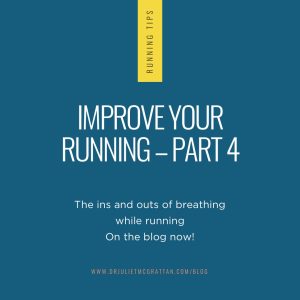You’re not alone if you’re in perimenopause and finding that your running is just getting slower and slower. It can be frustrating and demoralising. Despite your best efforts you just don’t seem to be able to pull any speed out of the bag. How can you run faster in perimenopause? How can you get your running back to where it was before the menopause kicked in?
Take a read of last week’s blog, ‘Why am I Running so Slowly in Perimenopause?’ where I discuss some of the reasons this could be happening. Now we’ll move on to what we can do about it.
Does speed matter?
Let’s be clear about this, speed doesn’t matter to everyone. If you’re happy as you are and aren’t bothered by time, then that’s fine. Slow running has lots of benefits, starting with being able to run and chat! A slow, long run is an essential part of every runner’s training plan. You may be enjoying taking your time, having pressure-free runs or even finding yourself able to go further when you go slower. Fantastic, this post may not be for you.
Speed as motivation
What I hear from women who are motivated by their pace and run times, is that when their speed drops in perimenopause, they begin to feel that their best running days are over. They don’t like that! They’re not ready to accept decline and still have unfinished business with their race goals. Plus, they just want to be able to have a fast run and enjoy it. We shouldn’t feel ashamed that we want to run fast. When so many of the run chat is about just enjoying your running and not focusing on speed, it almost feels wrong to want to strive for more and to keep performance high on your agenda.
I don’t think we should just have to accept a drop in performance. Yes, it can be hard and the challenges are many but there are things we can do to help keep our running tip top and dare I say it, to get faster and run better than ever.
Tips for running faster in perimenopause
Based on the four reasons I shared last week as to why you might be running more slowly, here are four areas to consider to turn each reason around.
- Clever training.
Consistent running is difficult in perimenopause. There are so many symptoms to contend with that make running hard. Get clever with the running that you are able to do. Don’t be tempted to always choose the easy paced run. If you want to get faster, you need to run faster, there’s no escape! Of course, some days, a speed session is out of the question. But, grab those good days and make the most of them.
Speed sessions don’t take long, you can be done and dusted in 30 minutes. A session that I enjoy is 10 mins slow running to warm up, then 10 x 80 metre sprint (with a slow jog or walk in between each one to get my breath back) and then 10 mins run to cool down. Don’t be afraid of sprinting. Find somewhere away from traffic, a park is ideal and just go for it. These types of high intensity sessions have big benefits for women around menopause. Do this once a week and you will start to see gains within a couple of months.
Don’t try to do all your runs fast. Make your slow runs lovely and slow. Do your speed sessions really fast. Don’t spend lots of time in the high mileage, quite a lot of effort zone. If you can’t train as much as you used to, focus on fewer good quality sessions.
Include plenty of recovery. You might need more than you used to. This could be the key to improving your performance. Perimenopause can just be plain exhausting and managing fatigue is important.
- Mindset shift.
Many women lose their drive and competitive spirit in perimenopause. This a tricky issue to overcome, especially when you want to push hard and run fast. Some women who use HRT find this helpful for their motivation but the evidence isn’t strong enough to prescribe it for this reason alone. Similarly, some women find that testosterone replacement (on top of oestrogen and progesterone) is the missing puzzle piece when it comes to their drive but again, the evidence isn’t there yet to make this standard.
Remember that this is a transient phase in your life and it doesn’t last forever. It’s likely that your full running mojo will return in time. A mindset shift can be helpful. You don’t necessarily need to be competitive to push through the tough times, you just need to be stubborn and have a reason. That may be as simple as challenging yourself to run the best you can on a given day. You can’t ask any more of yourself than giving it your best. Remain hopeful and positive.
- Build muscle.
We have to take action if we want to counteract the normal, gradual muscle loss that happens in our body as we age. For speed we need strong powerful muscles. I’m not going to sugar coat this. As a runner who has always struggled to get excited over strength work I know how hard this can be. But what are the options? Either we find a way to incorporate strength work into our routine and maintain or even build our muscle mass to set us up for a healthy future and bring some power back into our running, or we don’t, and we see the steady decline of our muscular mass and accept the associated health risks (and slower running) that come with it. Do it in whatever way works for you. The gym, home weights, a personal trainer, a class, it doesn’t matter but lift some weights, please.
I recommend exploring plyometrics too. These are explosive movements that train and strengthen fast twitch muscle fibres. They include jumping and hopping and done once or twice a week will help to add power to your running. You can read more about plyometrics here.
- Fuel well.
We get very set in our ways and this includes what and when we eat. Our body metabolism is changing and we need to adapt and change with it. Be open to the idea that you may need to change your eating habits.
To run fast you need a readily available supply of energy. You may have been able to run with little or no food previously but suddenly find it’s a disaster. A very short and easy fasted run might be ok but for an intense session you’ll probably now need to have eaten beforehand. A long day at work without much lunch isn’t going to set you up well for an after-work speed run. Experiment with eating a small amount before you run and see the difference it makes. Menopausal bodies don’t tend to perform well in the fasted state.
If you’re trying to reduce your weight or body fat and eating less as a result, it’s so easy to end up under fuelling your running. This can make you lethargic and lacking in energy and won’t result in faster run times and good speed sessions.
To build muscle for speed you need to eat plenty of protein, most of us don’t eat enough. Try to include some with every meal rather than having it all in one sitting.
Speed certainly isn’t everything but for those of us who want to see our stats improving it’s good to know there are things we can do and we don’t have to just accept decline.
- Be clever with your training
- Don’t be afraid of sprinting
- Be hopeful and positive
- Build some muscle
- Do some plyometrics
- Fuel your body properly.
I would love to know about your experience of running fast in perimenopause. Is it something you struggle with or are you finding you’re able to improve your times and performance? Tell me about your perimenopausal PBs!
If you’d like to get weekly tips and advice about running in the perimenopause and beyond then join the hundreds of women receiving my weekly newsletter, you can sign up below.
Featured image: runinspo at Pixabay







